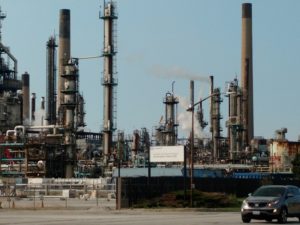Chemical Valley still in need of air pollution clean-up

By Colin Graf
AAMJIWNAANG FIRST NATION—A woman from Aamjiwnaang First Nation is taking the Ontario government to court over perceived failures to clean-up air pollution in the area, and she’s getting help from an unlikely source, an engineer in the government’s Ministry of the Environment and Climate Change.
Ada Lockridge, a long-time environmental activist, is “challenging the ongoing failure” of Environment Minister Glen Murray to finish a study on the cumulative effects of emissions from the cluster of oil and petrochemical plants known as Canada’s “Chemical Valley,” in Sarnia, ON, which virtually surrounds her community.
The study was first promised in 2009, court documents claim. The Minister is obliged to do the review “within a reasonable time,” under Ontario’s Environmental Bill of Rights, the papers state.
The review’s delay and missed deadlines for other promised steps to reduce air pollution in Aamjiwnaang are prompting claims of discrimination from inside the Ministry. In a letter to Chief Joanne Rogers, government engineer Scott Grant wonders “whether or not discriminatory attitudes by some senior managers of the MOECC may have played a role in the substantive delays in addressing concerns with air quality.”
Grant is asking the Ontario Human Rights Commission to investigate his claims, which date back to 2008, he tells Chief Rogers in the March 1, 2017 letter.
“Everybody has a right to a speedy trial,” but eight years is far too long to wait for the government to review the cumulative effects of the different chemicals residents in the area are exposed to, Lockridge says.
With help from the environmental group Ecojustice, Lockridge asked for the review to be completed by May 11, the eight-year anniversary of the promise from an earlier Minister to conduct the review. When no meaningful response was given, they went to court, says Ecojustice lawyer Kaitlyn Mitchell.
The review should be completed next fall, says ministry spokesperson Gary Wheeler. He could not comment on the legal case as it is before the courts. As for Grant’s allegations of bias, Wheeler said the ministry takes any allegations of discriminatory behaviour very seriously, and is investigating.
Chemical Valley industries released 55,000 tonnes of pollution into the air in 2015, based on industry-reported data, Mitchell says. She says that the government’s approach of setting limits for each individual chemical compound doesn’t deal with the possible combined effects of this “soup”, or the cumulative effects over years of exposure.
Lockridge suspects government scientists don’t understand what the cumulative and combined effects of different chemicals are.
“I’ve sat in on meetings where they say they don’t know,” recalls Lockridge.
She remembers preparing the paperwork in 2008 to ask for the long-delayed investigation, and how she’s taken “a lot of years to learn what these plants do and what the chemicals they produce are.”
“It’s been quite a learning experience,” notes Lockridge. “You can’t just learn all this and then just walk away because the government isn’t acting.”
One of her activities is taking “bucket samples” for testing air quality. Lockridge thinks that it’s ironic that the samples go to California for testing, where American air standards apply which are, in the case of some Chemical Valley pollutants, tougher than Canadian ones.
“For some of these chemicals we don’t even have standards. Give us a break here,” she fumes.
Aamjiwnaang is also stuck waiting for new limits on emissions of the lung-irritating chemical sulphur dioxide (SO2). New SO2 regulations were promised in 2014, again the next year, and yet again for the end of 2016, Chief Rogers described in a letter to the Minister last December.
In March, Minister Murray wrote back to say that the SO2 limits would be ready in the spring, although everyone is still waiting, says Elaine MacDonald, Ecojustice environmental engineer.
Aamjiwnaang’s environmental coordinator, Sharilyn Johnston, also said she’s noticed the slowdown at the Ministry.
Sulphur dioxide is legally toxic, according to the Canadian Environmental Protection Act, Chief Rogers writes in her letter.
“Exposure to higher levels of sulphur dioxide poses a significant increase in respiratory conditions such as asthma and bronchitis,” she claims. Many community members suffer from those conditions, she says in the letter.
MacDonald says she has been told industry has been engaged in “heavy lobbying” as high up as the premier’s office, which may have caused some of the delays.
Ministry spokesperson Wheeler said officials consulted with industry and Indigenous communities on the science supporting new sulphur dioxide standards in the spring of 2016. Data collected by the province shows air quality has improved noticeably over the last 10 years, according to Wheeler.
Analysis of the data collected at the Aamjiwnaang air monitoring station from 2008 to 2015 indicates air contaminants have decreased, and the ministry will continue to work collaboratively with First Nations partners to ensure that this trend continues, he said.
A spokesperson for Sarnia industries says the companies are not to blame for the delays in the new regulations. The oil and gas industry is working with government on establishing new air standards the same way government consults other stakeholders, including First Nations, said Dean Edwardson, general manager of the Sarnia-Lambton Environmental Association, a group of 20 industrial manufacturers.
The sulphur dioxide problem is improving in the Sarnia area, according to Edwardson’s association. Emission levels had been decreasing for over 10 years, and have been below current government-approved levels for years, he says.


